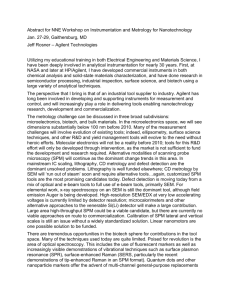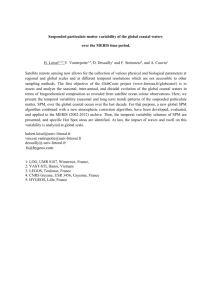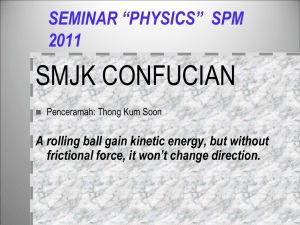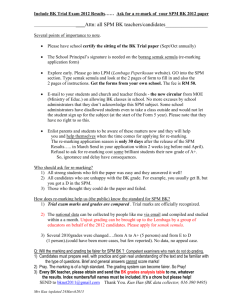conflict of laws
advertisement
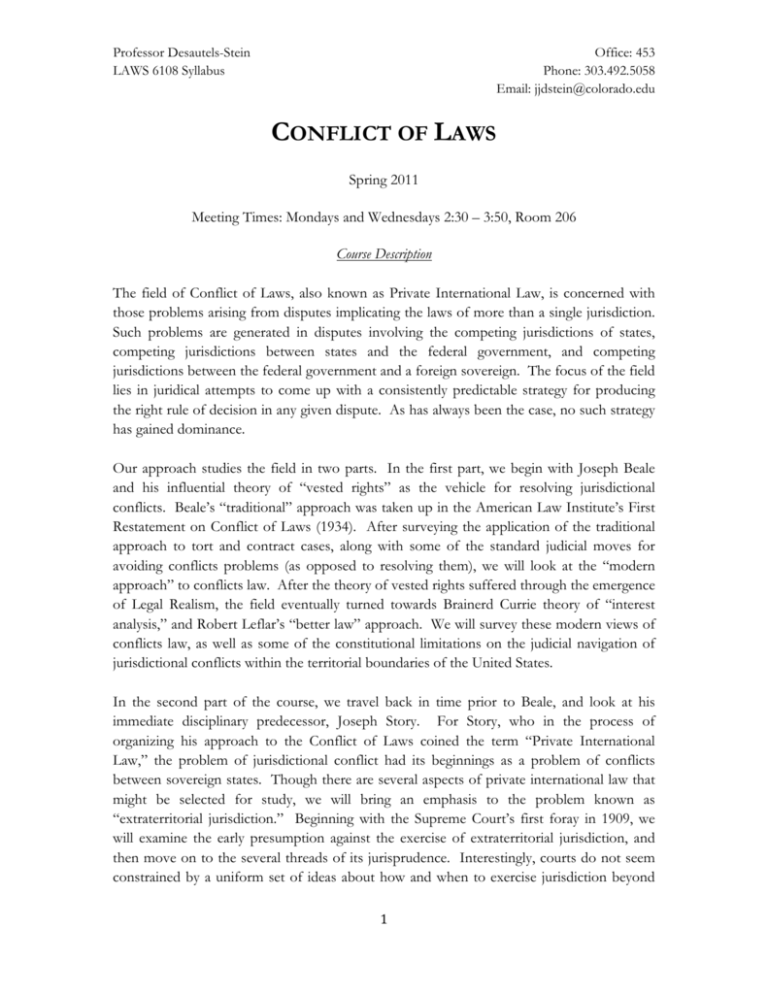
Professor Desautels-Stein LAWS 6108 Syllabus Office: 453 Phone: 303.492.5058 Email: jjdstein@colorado.edu CONFLICT OF LAWS Spring 2011 Meeting Times: Mondays and Wednesdays 2:30 – 3:50, Room 206 Course Description The field of Conflict of Laws, also known as Private International Law, is concerned with those problems arising from disputes implicating the laws of more than a single jurisdiction. Such problems are generated in disputes involving the competing jurisdictions of states, competing jurisdictions between states and the federal government, and competing jurisdictions between the federal government and a foreign sovereign. The focus of the field lies in juridical attempts to come up with a consistently predictable strategy for producing the right rule of decision in any given dispute. As has always been the case, no such strategy has gained dominance. Our approach studies the field in two parts. In the first part, we begin with Joseph Beale and his influential theory of “vested rights” as the vehicle for resolving jurisdictional conflicts. Beale’s “traditional” approach was taken up in the American Law Institute’s First Restatement on Conflict of Laws (1934). After surveying the application of the traditional approach to tort and contract cases, along with some of the standard judicial moves for avoiding conflicts problems (as opposed to resolving them), we will look at the “modern approach” to conflicts law. After the theory of vested rights suffered through the emergence of Legal Realism, the field eventually turned towards Brainerd Currie theory of “interest analysis,” and Robert Leflar’s “better law” approach. We will survey these modern views of conflicts law, as well as some of the constitutional limitations on the judicial navigation of jurisdictional conflicts within the territorial boundaries of the United States. In the second part of the course, we travel back in time prior to Beale, and look at his immediate disciplinary predecessor, Joseph Story. For Story, who in the process of organizing his approach to the Conflict of Laws coined the term “Private International Law,” the problem of jurisdictional conflict had its beginnings as a problem of conflicts between sovereign states. Though there are several aspects of private international law that might be selected for study, we will bring an emphasis to the problem known as “extraterritorial jurisdiction.” Beginning with the Supreme Court’s first foray in 1909, we will examine the early presumption against the exercise of extraterritorial jurisdiction, and then move on to the several threads of its jurisprudence. Interestingly, courts do not seem constrained by a uniform set of ideas about how and when to exercise jurisdiction beyond 1 Professor Desautels-Stein LAWS 6108 Syllabus Office: 453 Phone: 303.492.5058 Email: jjdstein@colorado.edu US borders, despite help from the Restatements of Foreign Relations Law and Conflict of Laws dealing with the subject. Instead, courts appear happy to apply US law over international disputes when the subject is US economic law, but are hesitant to do the same in the contexts of US environmental, discrimination, and constitutional law. We will close the course by reading a sample of current approaches to these inconsistencies, including theories of universal jurisdiction, legal pluralism, and culture. Participation, Exam, and Grading The exam will be take-home. My expectation is that every student will participate in all class discussions. I reserve the right to adjust your final grade in proportion with your participation in the class. Readings The required textbook for the course is Symeon Symeonides, Wendy Perdue, and Arthur von Mehren’s Conflict of Laws: American, Comparative, International (2nd Edition 2003) (“SPM”). Additional required readings will be available as a coursepack in the bookstore, as well on the course’s TWEN site. The reading for Assignment 1 should be completed in preparation for the first day of class. Law School Attendance Policy §3-3-1 Absences Absence by a student from more than twenty percent of the total number of classes or lectures in any course will exclude the student from examinations in the course and the grade given shall be "F" (numerical grade 50) save in exceptional cases when, by vote of the faculty upon written petition, the student will be permitted to drop the course, and except when this rule is waived as provided hereinafter. In his or her discretion, the instructor of the course may permit a student who has been absent from more than 20% of the classes to take the final examination, subject to a penalty of five points on the student's numerical grade for each excessive absence, or some lesser penalty as determined by the instructor. Such penalties shall be subtracted from the student's grade before recording in the Dean's Office, and the lowered numerical grade shall control the official letter grade reported to the University. Any instructor may waive this rule. 2 Professor Desautels-Stein LAWS 6108 Syllabus Office: 453 Phone: 303.492.5058 Email: jjdstein@colorado.edu Assignments Introduction Assignment 1—Conflict of Laws as State Law • SPM, pp. 1-6 Assignment 2—Conflict of Laws as Private International Law • • Joel Paul, The Isolation of Private International Law, 7 Wisconsin Journal of International Law (1988), pp. 149-155. Th.M. de Boer, Living Apart Together: the Relationship Between Public and Private International Law, 57 Netherlands International Law Review 183 (2010) (24 pages) Part 1: Conflict of Laws as State Law 1. The Traditional View Assignment 3—Joseph Beale • • Annelise Riles, A New Agenda for the Cultural Study of Law: Taking on the Technicalities, 53 Buffalo Law Review 973 (2005), pp. 989-993. Joseph Beale, Selections from Beale’s Treatise on the Conflicts (1935), pp. 1-22. Assignment 4—Torts • SPM, pp. 16-26 (notes 1, 2, 4, 7-9) Assignment 5—Contracts • • SPM, pp. 30-36 Pritchard v. Norton, 106 US 124 (1882) 3 Professor Desautels-Stein LAWS 6108 Syllabus Office: 453 Phone: 303.492.5058 Email: jjdstein@colorado.edu Assignment 6—Escapes—Characterization • SPM, pp. 41-53 (notes 1-5, 8-9), (notes 1-4) Assignment 7—Escapes—Substance and Procedure • SPM, pp. 55-61, 63-65 Assignment 8—Application of Designated Law • SPM, pp. 66-69, 73-90 (notes 1-4, 9-13), (notes 1, 2, 4, 6-8) 2. The Modern View Assignment 9—Legal Realism • • Annelise Riles, A New Agenda for the Cultural Study of Law: Taking on the Technicalities, 53 Buffalo Law Review 973 (2005), pp. 989-993. Joseph Singer, Legal Realism Now, 76 California Law Review 468 (1988), pp. 475-503 Assignment 10—The Realist Critique of the Traditional View of Conflicts • Walter W. Cook, The Logical and Legal Bases of the Conflict of Law, 33 Yale L. J. 457 (1924) Assignment 11—Brainerd Currie’s Center of Gravity • • • SPM, pp. 117-123 Annelise Riles, A New Agenda for the Cultural Study of Law: Taking on the Technicalities, 53 Buffalo Law Review 973 (2005), pp. 1008-1021. Brainerd Currie, Selected Essays on the Conflict of Laws (1963), pp. 177-187 Assignment 12—False Conflicts • SPM, pp. 124-141 (notes 1, 2, 5-6) 4 Professor Desautels-Stein LAWS 6108 Syllabus Office: 453 Phone: 303.492.5058 Email: jjdstein@colorado.edu Assignment 13—True Conflicts • SPM, pp. 179-193 Assignment 14—The “No-Interest” Case • SPM, pp. 233-242 (note 1) Assignment 15— The Second Restatement Compromise • • SPM, pp. 141-145, 152-158 Phillips v. General Motors, 995 P2d 1002 (2000) Assignment 16—Robert Leflar’s “Better Law” • • Robert Leflar, Conflicts Law: More on Choice-Influencing Considerations, 54 California Law Review 1584 (1966), pp. 1585-1588 SPM, pp. 161-171 Assignment 17—Constitutional Limits—Due Process, Full Faith and Credit • SPM, pp. 441-461, 480-489 Assignment 18—Constitutional Limits—Discrimination, Commerce • • SPM, pp. 494-496, 507-512 Supreme Court of New Hampshire v. Piper, 470 US 274 (1985) 5 Professor Desautels-Stein LAWS 6108 Syllabus Office: 453 Phone: 303.492.5058 Email: jjdstein@colorado.edu Part 2: Extraterritorial Jurisdiction Assignment 19—Recognition of Foreign Judgments; Comity • • • SPM, pp. 811-823 Joseph Story, Commentaries on the Conflict of Laws (1834), pp. 1-10, 19-37 Joel Paul, The Transformation of International Comity, 71 Law & Contemp. Probs. 19 (2008) Assignment 20—The Early Presumption Against Extraterritorial Jurisdiction • • • • SPM, pp. 537-542, 550-557 American Banana Co. v. United Fruit Co., 213 US 347 (1909) Blackmer v. United States, 284 US 421 (1932), pp. 2-4 Foley Bros. v. Filardo, 336 US 281 (1949), pp. 2-5 Assignment 21—The Restatements’ Approach to Extraterritorial Jurisdiction • • • Andreas Lowenfeld, International Litigation and the Quest for Reasonableness (1996), pp. 15-20, 29-32, 228-232 Restatement Second, Conflict of Laws, Section 6, Comment on (2)(a) Restatement Third, Foreign Relations Law, Section 401 and Comment; Section 402 and Comment; Section 403 and Comment; Section 421 and Comment (a); Section 431 and Comment (a). Assignment 22—Extraterritorial Application of US Antitrust Law • • • • United States v. Aluminum Co. of America, 148 F2d 416 (2nd Cir. 1945), pp. 26-27 Timberlane Lumber Co. v. Bank of America, 549 F2d 597 (9th Cir. 1977), pp. 8-10 (skim), 11-14 Hartford Fire Insurance Co. v. California, 509 US 764 (1993), pp. 12-13 F. Hoffman-LaRoche v. Empagran, 542 US 155 (2004), pp. 6-8 Assignment 23—Extraterritorial Application of US Environmental Law • Lujan v. Defenders of Wildlife, 504 US 555 (1992) (Stevens, J. concurring), pp. 14-15 6 Professor Desautels-Stein LAWS 6108 Syllabus • • Office: 453 Phone: 303.492.5058 Email: jjdstein@colorado.edu Environmental Defense Fund v. Massey, 986 F2d 528 (DC Cir. 1993), pp. 2-7 Arc Ecology v. US Dept of Air Force, 411 F3d 1092 (9th Cir. 2005), pp. 2-5, 7-8 Assignment 24—Extraterritorial Application of US Discrimination Law/Labor Law • • • EEOC v. Aramco, 499 US 244 (1991), pp. 3-8 Denty v. Smithkline Beecham Co., 109 F3d 147 (3rd Cir. 1997) Asplundh Tree Expert Company v. National Labor Relations Board, 365 F3d 168 (3rd Cir. 2004) Assignment 25—Extraterritorial Application of US Constitutional Law • • • Reid v. Covert, 354 US 1 (1957), pp. 1-6 (end with section II) US v. Verdugo-Urquidez, 494 US 259 (1990), pp. 3-8 (end before headnote 7), pp. 10-14 (Brennan Dissent) Boumediene v. Bush, 553 U.S. 723 (2008), pp. 10-12 (Section I), 15-25 (Sections IIIB, IV), 47-55 (Scalia Dissent) Assignment 26—Do we have a Theory? Universal Jurisdiction • • The Princeton Principles on Universal Jurisdiction, in Universal Jurisdiction (Stephen Macedo, ed., 2004), pp. 21-25. Richard Falk, Assessing the Pinochet Litigation: Whither Universal Jurisdiction?” in Universal Jurisdiction (Stephen Macedo, ed., 2004), pp. 97-120. Assignment 27—Do we have a Theory? Legal Pluralism • Paul Schiff Berman, Towards a Cosmopolitan Vision of Conflict of Laws: Redefining Governmental Interests in a Global Era, 153 University of Pennsylvania Law Review 1819 (2005), pp. 1839-1872 Assignment 28—Do we have a Theory? Conflicts as Culture • Annelise Riles, Cultural Conflicts, 71 Law & Contemp. Probs. 273 (2008), pp. 273-308 7





